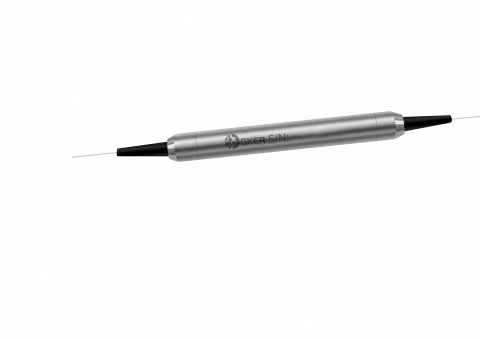2 µm Polarization Maintaining Isolator (PMI Series)
For pricing, technical or any other questions please contact the supplier
- No registration required
- No markups, no fees
- Direct contact with supplier
-
Ships from:
China
-
Sold by:
-
On FindLight:
since 2024
Description
The 2 µm Polarization Maintaining Isolator (PMI Series) is a state-of-the-art optical device engineered to meet the rigorous demands of modern laser systems. Compliant with Telcordia standards, this isolator is designed to offer unparalleled performance and reliability. The unique manufacturing process, featuring an epoxy-free optical path, enhances the device’s ability to handle high power levels, making it an ideal choice for applications that require high precision and stability.
Specially crafted for 2 µm laser systems, the PMI Series isolator is characterized by its high isolation, low insertion loss, and superior return loss. It is available in both single-stage and dual-stage configurations, allowing users to select the optimal isolation level for their specific needs. With multiple connector options and versatile fiber jacket choices, this isolator provides flexibility and adaptability for a wide range of applications.
Whether you are working in spectroscopy, medical equipment, materials processing, telecommunications, or scientific research, the 2 µm Polarization Maintaining Isolator ensures efficient performance, maintaining the integrity of your optical signals and enhancing the overall functionality of your system.
2 µm Polarization Maintaining Isolator (PMI Series)
Specifications |
|
|---|---|
| Type Of The Device: | Isolator |
| Operating Wavelength: | 2000 nm |
| Max Power: | 1 W |
| Min Isolation: | 16 dB |
| Center Wavelength (λc): | 2 µm |
| Min. Extinction Ratio: | 18 dB |
| Min. Isolation, λc ± 50 Nm, 23 ℃, All Polarization States: | Single stage:16, Dual stage: 35 dB |
| Max. Average Optical Power: | 1, 2 W |
| Max. Peak Power For Ns Pulse: | 10 kW |
Features
- Telcordia Standard Compliance: Designed and manufactured to meet stringent Telcordia standards, guaranteeing high reliability and industry-leading performance
- High Power Handling: Epoxy-free optical path design enhances the isolator's capacity to handle high optical power levels, ensuring stability and durability even under intense operational conditions
- Superior Isolation: Available in both single-stage and dual-stage configurations to provide optimal isolation, minimizing back reflections and ensuring signal integrity
- Low Insertion Loss: Engineered to deliver minimal insertion loss, maintaining high transmission efficiency across the specified wavelength range
- Multiple Connector Options: Compatible with various connector types including FC/UPC, FC/APC, SC/UPC, SC/APC, and custom specifications, offering flexibility for different system requirements
- Versatile Fiber Jacket Options: Available with different fiber jackets such as 250 µm Panda Fiber and 900 µm Loose Tube, catering to diverse application needs
- Customizable Parameters: Offers customizable handling power, fiber length, working axis, and power type to meet specific application demands
- Robust Construction: High-quality construction ensures long-term reliability and performance, withstanding harsh environmental conditions
Applications
- 2 µm Laser Systems: Ideal for integration into advanced 2 µm laser systems, providing reliable isolation and maintaining polarization integrity
- Spectroscopy: Enhances the accuracy and efficiency of spectroscopic measurements by preventing unwanted reflections and maintaining signal purity
- Medical Equipment: Utilized in medical laser systems where precise control of light is critical for procedures and diagnostics
- Materials Processing: Supports high-power laser applications in materials processing, ensuring stable and consistent performance
- Telecommunications: Ensures optimal signal transmission and minimal loss in fiber optic communication systems operating at 2 µm
- Scientific Research: Facilitates advanced research in optics and photonics by providing reliable performance in experimental setups
Frequently Asked Questions
A polarization maintaining isolator is an optical device designed to allow light to pass through in one direction while blocking it in the opposite direction. It typically consists of a polarizer, a Faraday rotator, and an analyzer. The Faraday rotator rotates the polarization of the light, allowing it to pass through the device in one direction while blocking it in the reverse direction.
The 2 µm Polarization Maintaining Isolator features high power handling capability, low insertion loss, high isolation, and superior reliability. It is compliant with Telcordia standards and offers customizable options for connectors, fiber jackets, and other parameters to suit specific application requirements.
This isolator is commonly used in 2 µm laser systems for applications such as spectroscopy, medical equipment, materials processing, telecommunications, and scientific research. It ensures stable and efficient performance by preventing back reflections and maintaining signal purity.
The PMI Series isolator offers various options for wavelength, power handling, connector type, fiber jacket, and other parameters. To select the optimal configuration for your application, consider factors such as the operating wavelength, power requirements, environmental conditions, and compatibility with existing optical components.
Single-stage isolators provide basic isolation, while dual-stage isolators offer higher levels of isolation, making them suitable for applications that require enhanced signal purity and suppression of back reflections. Dual-stage isolators typically have higher insertion loss but provide superior performance in demanding environments.
This isolator is backed by a warranty against manufacturing defects, and technical support is available to assist with installation, operation, and troubleshooting. For specific warranty terms and support options, please refer to the product documentation or contact our customer support team.
Yes, the PMI Series isolator offers customization options for wavelength, power handling, connector type, fiber jacket, and other parameters. Our team can work with you to tailor the isolator to your unique specifications and application needs.

